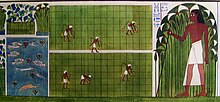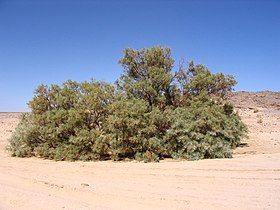Gardens of ancient Egypt
The gardens of ancient Egypt probably began as simple fruit orchards and vegetable gardens, irrigated with water from the Nile. Gradually as the country became richer, they evolved into pleasure gardens with flowers, ponds and valleys of fruit and shade trees. Temples, palaces, and private residences had their own gardens, and models of gardens were sometimes placed in tombs so their owners could enjoy them in their afterlife.[1]
History
The history and character of
Palace gardens
Palace gardens first appeared in Egypt just before the Middle Empire (2035–1668). These gardens were very large in scale, and were laid out in geometric patterns. The ponds of palace gardens were enormous and numerous. In the second millennium BC, the garden pond of King Sneferu was large enough for boats rowed by twenty oarsmen.
The rulers of ancient Egypt, such as Queen
Pleasure gardens
Beginning during the time of the New Kingdom, pleasure gardens became a common feature of luxury residences. According to paintings in tombs in Thebes from the 18th Dynasty (1552–1296 BC), gardens of that time had a standard design. They had a pond, usually rectangular, in the center, filled with colorful fish, with lotus blossoms in the water and flowers around the edges. Around the pond were successive rows of trees, including sycamores, palms, and pomegranates, alternating with flower beds. The edges of the water basins were sloping, with a stairway down one side so gardeners could collect water for irrigation.[3]
The pond was often surrounded by walls or columns supporting grapevines. The walls and columns were decorated with colorful paintings of people, animals, and plants such as the poppy and rose.
Temple gardens

Temples often had extensive gardens. The Temple of Amun at Karnak had twenty-six kitchen gardens, alongside a very early botanical garden, which, according to an inscription, contained "all kinds of beautiful flowers and bizarre plants which are found in the divine land which His Majesty has conquered."[4] The hymns painted on the walls of tombs show that religious ceremonies centered on the cycles of nature and the changing seasons. Temple gardens often had rows of fig trees and sycamores (the tree sacred to the goddess Hathor), tamarisks, willows, or palm trees. Rows of trees sometimes stretched for several kilometers, connecting several temples. The temples themselves had esplanades planted with trees. When rows of trees were planted far from the river, wells had to be dug ten meters deep to reach water for irrigation. During the time of
Funeral gardens
Funeral gardens were miniature versions of house gardens that were placed in tombs. They usually had a small square house or pavilion with wooden columns, surrounded by a wall, Within the wall was a basin surrounded by a row of trees. The house resembled the kiosks in gardens, where the owner would play checkers or relax. The dead were traditionally surrounded by the objects they would have enjoyed in life, and it was expected that they would continue to enjoy their gardens in their afterlife.[7] The inscription of one tomb said: "You promenade at your ease by the lovely bank of your pond; your heart rejoices from your trees and is refreshed under your sycamores; your heart is satisfied by the water from your wells that you made so that they would last forever."[8]
Trees and plants in the Egyptian garden
Trees were used in the gardens to produce fruit and for shade. Nineteen different species of trees were found in the gardens of
) and tamarisk trees were sometimes planted in front of temples, as they were at the temple of Nebhepetra, from the 11th century BC.The
The most common fruit trees were date palms, fig trees and doum palms (
Egyptian ponds and basins were often decorated white and blue lotus (
-
The date palm, used by the Ancient Egyptians both as a food and for making wine. The Egyptians learned to pollinate the trees by hand.
-
The Persea indica tree, in the same family as the avocado, once common in Egypt, has vanished there but can still be found in the Azores and Canary Islands.
-
The sycamore (Ficus sycomorus) was often planted for shade. It was also often planted at temples, and its wood was used for making coffins for mummies.
-
Tamarisktree, used for shade
-
Fruit of the Pomegranate tree, introduced during the New Kingdom, used as a medicine against tapeworm various infections.[11]
-
Blue Egyptian lotus, found in garden ponds
-
Cyperus papyrus was used as a writing material, for making boats, and even eaten.
Ponds and pools
Ponds and pools were a common feature of the residential gardens of the wealthy and powerful of ancient Egypt, and are shown in a number of tomb paintings. Sometimes, as in the garden of
Flowers such as white and blue lotus were grown in the ponds for decoration and for ceremonies, and papyrus was known to grow at Deir el-Bahri.[12] Later, during the Persian occupation of Egypt, the pink lotus was introduced.
Shade, color and aroma
Shade was an important feature of the garden, provided by trees and by grapevines supported between columns. Describing these gardens, Shaw and Nicholson wrote: "The overall effect would have been one of cool shade, heavy with the fragrance of the flowers and the trees. Gardens are therefore one of the most frequent settings of Egyptian romantic tales."[12]

Gardening in ancient Egypt
Gardening in ancient Egypt was very hard work; gardens required constant irrigation, with water carried or lifted by hand, weeding, and tending, including the artificial propagation of date palms, which required great skill. Great effort was also needed to keep birds from eating the crops. Ingenious traps were set to catch the invading birds.[13]
References
- ^ Baridon, Les Jardins, pg. 103
- ^ I.M. Gallery, The Garden of Ancient Egypt, article in D. Schmandt-Besserat, Immortal Egypt. Undena Publications, 1978, pg. 47.
- ^ Descroches-Noblecourt, L’Art Egyptien, pg. 113
- ^ Cited in Baridon, pg. 97.
- ^ Baridon, Les Jardins, pg. 102.
- ^ Baridon, pg. 102
- ^ G. Maspero, Etudes d’archeologie et de la mythologie egyptienne, Paris, Bibliotheque egyptologique, 1890, volume 2, page 221.
- ^ Hugonot, pg. 170
- ISBN 0801442419
- ^ Zohary and Hopf, pg. 165
- ^ The medicinal properties of the pomegranate are described in the Ebers Papyrus, a medical text from about 1550 B.C.
- ^ a b Shaw and Nicholson, The British Museum Dictionary of Ancient Egypt.
- ^ Baridon, pg. 97.
Bibliography
- Ian Shaw and Paul Nicholson, The British Museum Dictionary of Ancient Egypt, British Museum Press, 1995.
- Michel Baridon, Les Jardins – Paysagistes- Jardiniers – Poetes. Editions Robert Lafont, 1998. (ISBN 2-221-06707-X)
- Jan Assmann, David Lorton,"Death and salvation in ancient Egypt", Translated by David Lorton, p171, Cornell University Press, 2005, ISBN 0801442419
- Daniel Zohary and Maria Hopf, Domestication of plants in the Old World, third edition (Oxford: University Press, 2000).
- C. Desroches-Noblecourt, L’Art Egyptien, PUF, Paris, 1962.
- J.C. Hugonot, Le Jardin dans l’Egypte ancienne, Peter Lang, Paris, 1989.






![Fruit of the Pomegranate tree, introduced during the New Kingdom, used as a medicine against tapeworm various infections.[11]](http://upload.wikimedia.org/wikipedia/commons/thumb/2/29/Pomegranate03_edit.jpg/280px-Pomegranate03_edit.jpg)


